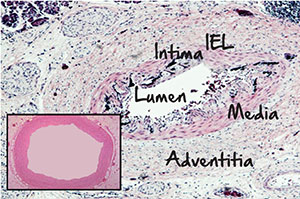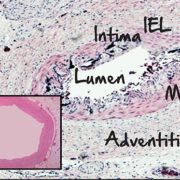How a rare disease treatment could impact millions

Post-mortem image shows significant narrowing of the artery in an infant with GACI due to buildup of calcium crystals between the vessel wall’s inner and middle layers. Inset: Normal non-calcified artery. Patients with GACI lack the protein ENPP1, which is responsible for creating pyrophosphate. Pyrophosphate plays a critical role in preventing calcium crystallization and accumulation.
One of the first patients I ever saw with generalized arterial calcification of infancy (GACI) was actually the third child with this condition born to the same parents. GACI is a rare genetic disease, occurring in 1 of 200,000 live births. Unfortunately, as is common in GACI, two of the family’s children previously succumbed to the disorder within the first 6 weeks of life.
GACI causes calcium to build up in the arteries, causing critical blockages that reduce blood flow to organs leading to diminished function, including stroke, heart attack, and death.
Etidronate, a pyrophosphate analog developed to treat osteoporosis, has shown limited success at replacing the pyrophosphate for patients with GACI. However, more than 55 percent of children with GACI still die before their first birthday.
We need more effective solutions. Several treatment options are in development, including the administration of ENPP1 bound to an antibody, which has shown to provide a marked survival improvement in a mouse model of the disease.
These new solutions could translate to more effective treatment of GACI but also other conditions causing calcification in the arteries, particularly the calcium buildup associated with long-term kidney disease. A treatment that potentially reduces morbidity for the estimated 20 million plus Americans with chronic kidney disease would have tremendous health and economic benefits.
Developing more targeted therapies for GACI could allow this to be the outcome for many more patients, both children with GACI and potentially also patients affected by chronic kidney disease.
About the Author
 Carlos Ferreira Lopez, M.D.
Carlos Ferreira Lopez, M.D.
Geneticist Specialist



